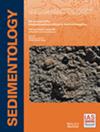Shallow‐marine calciclastic mass‐transport deposits in an evolving thrust‐top basin: A case study from the North Dalmatian foreland basin, Croatia
IF 2.8
2区 地球科学
Q1 GEOLOGY
引用次数: 0
Abstract
ABSTRACT Mass‐transport deposits are products of resedimentation phenomena involving a broad spectrum of gravity‐driven processes, and commonly have a high preservation potential in deep‐marine environments. This study documents various types of mass‐transport deposits that are interbedded with intensely bioturbated shallow‐marine calciclastic sediments deposited along a reflective coast during the middle and late Eocene. The sedimentary succession, located in the vicinity of Novigrad in northern Dalmatia, Croatia, comprises sediments deposited in a range of nearshore and carbonate ramp environments, and represents the infill of a thrust‐top (piggyback) basin of the North Dalmatian foreland basin. Five types of mass‐transport deposits, ranging in thickness from 13 cm to 6 m, have been identified: (i) calcilutite and calcarenite slumps; (ii) conglomeratic slump‐debrites with a ‘dough‐like’ appearance; (iii) blocky‐flow deposits bearing large blocks of beachface and/or shoreface deposits; (iv) rockfall deposits comprising scattered blocks of beachface conglomerates and shoreface calcarenites; and (v) ‘classical’ matrix‐supported debrites. Calciturbidites are rare and mainly comprise Ta and Tb divisions. Conglomeratic slump‐debrites are mostly found in association with offshore‐transition deposits, suggesting that mass flows were triggered above the storm wave base likely due to a combined effect of: (i) strong earthquakes related to the tectonic development of the basin; (ii) sediment destabilization due to pore‐water overpressure during forced regressions; and (iii) storm‐wave loading affecting the shallow seabed. Progressive deepening likely favoured mass‐flow transformations, although the overall paucity of turbidites suggests relatively short mass‐flow transport distance and turbidity current bypass to deeper realms. Multiple erosion phases and resedimentation processes from the Cretaceous to the late Eocene contributed to the diverse suite of extraformational clasts in the mass‐transport deposits studied. The mass‐transport deposits may be triggered and emplaced in shallow‐marine settings mainly during regressive stages of basin development, as the diverse gravel clast composition suggests significant tectonic influence. Although the mass‐transport deposits reported herein are relatively small, some of their peculiar sedimentary features and occurrence within shallow‐marine calciclastic deposits render them rather unique and suitable for a re‐assessment of the nature and evolutionary continuum of processes involved in subaqueous sediment mass transport, as well as the preservation potential of sedimentary features in high‐energy wave‐reworked environments.演化中的逆冲顶盆地中的浅海钙质块体搬运沉积:以克罗地亚北达尔马提亚前陆盆地为例
质量搬运沉积物是再沉积现象的产物,涉及广泛的重力驱动过程,通常在深海环境中具有很高的保存潜力。本研究记录了始新世中晚期沿反射海岸沉积的强烈生物扰动浅海钙质碎屑沉积物互层的各种类型的质量搬运沉积物。该沉积序列位于克罗地亚北部达尔马提亚的Novigrad附近,包括沉积在一系列近岸和碳酸盐斜坡环境中的沉积物,代表了北达尔马提亚前陆盆地的逆冲顶部(背带)盆地的充填。已经确定了五种类型的块体搬运矿床,厚度从13厘米到6米不等:(1)方解石和方解石滑塌;(ii)具有“面团状”外观的砾岩滑塌碎屑;(iii)含有大块滩面和/或滨面沉积物的块状流沉积物;(iv)由散落的滨面砾岩块和滨面钙质块组成的岩崩矿床;(v)“经典”基质支撑碎屑。钙矾石罕见,主要由Ta和Tb分裂组成。砾岩滑塌碎屑大多与近海过渡沉积相关联,表明风暴波基底上方的物质流动可能是由以下因素共同作用引发的:(1)与盆地构造发育有关的强震;(ii)强迫回归期间孔隙水超压导致沉积物失稳;(iii)影响浅海底的风暴波载荷。逐渐加深可能有利于质量流转换,尽管浑浊岩的总体缺乏表明相对较短的质量流传输距离和浑浊流绕道到更深的领域。从白垩纪到晚始新世的多个侵蚀阶段和再沉积过程导致了所研究的质量搬运沉积物中各种各样的地层外碎屑。由于砾石碎屑组成的多样性表明了明显的构造影响,这些块体搬运矿床可能主要在盆地发育的退退阶段在浅海环境中被触发和安置。虽然本文报道的质量搬运沉积相对较小,但它们在浅海钙质沉积中的一些特殊沉积特征和分布使它们非常独特,适合于重新评估水下沉积物质量搬运过程的性质和演化连续体,以及高能量波重加工环境中沉积特征的保存潜力。
本文章由计算机程序翻译,如有差异,请以英文原文为准。
求助全文
约1分钟内获得全文
求助全文
来源期刊

Sedimentology
地学-地质学
CiteScore
8.20
自引率
11.40%
发文量
94
审稿时长
6-12 weeks
期刊介绍:
The international leader in its field, Sedimentology publishes ground-breaking research from across the spectrum of sedimentology, sedimentary geology and sedimentary geochemistry.
Areas covered include: experimental and theoretical grain transport; sediment fluxes; modern and ancient sedimentary environments; sequence stratigraphy sediment-organism interaction; palaeosoils; diagenesis; stable isotope geochemistry; environmental sedimentology
 求助内容:
求助内容: 应助结果提醒方式:
应助结果提醒方式:


